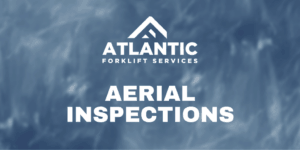Like any piece of equipment you rely on, your aerial lifts require regular inspections, and regularly.
Aerial lifts also have their own set of unique safety requirements, and let’s start this review here.
OSHA defines an aerial lift, simply, as a vehicle used to lift someone in the air. We’re paraphrasing here, but you know what an aerial lift is.
Some of the hazards include brushes with gravity for both the operator and any objects the lift may be handling; the high center of gravity causing the vehicle to tip over; electrocutions caused by not observing overhead electrical lines; and contact with the ceiling.
We talk repeatedly about how most safety measures in the workplace really are grounded in common sense, and an aerial lift is no different. Use fall protection in the lift basket; watch carefully where your operator is raising the basket and check for overhead electrical and low ceilings; use the outriggers if the unit is equipped with them.
OSHA recommends a pre-shift inspection to ensure all the equipment is in safe operating condition- including a walk-around, checking for leaks, safety gear like horns and back-up alarms, etc. As with the pre-shift forklift inspection, if anything shows up in this procedure as faulty, the equipment must be taken out of the rotation until it is repaired.
Frequent inspections are required in addition to the daily routine. Every three months or 150 hours (whichever comes first) OSHA requires an inspection administered by aa mechanic who has been trained on that specific piece of equipment.
In addition, because of the unique nature of the aerial lift, structural inspections are required as well, and should be conducted more frequently the older the unit gets.
Atlantic Forklift Services can perform these aerial lift inspections when you need them and our trained professionals can evaluate, identify trouble, and repair to make sure your equipment gets back on the floor as quickly as possible.

